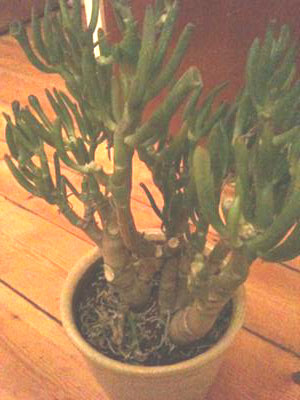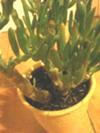
(London)



Can you please identify this plant? I’ve had it since April.
This succulent plant has green bell-shaped leaves growing from thick stems, and it’s survived all year with no water, sitting inside by a large window.
In recent weeks it has started to lose leaves. I’m not sure if it is thirsty (probably) or cold due to the winter.
Any suggestions and an identification would be most appreciated!
Comments for Thick Stemmed Succulent Plant
Aug 06, 2018
Name of Your Plant
by: Todd M
I believe it’s Called crassula gollum.
Dec 23, 2010
Great advice
by: Jacki
Thanks Emma – I knew someone would recognize this little guy, and know what it was. I’ve seen it before, but didn’t know the name. Another one added to my wish list!
Dec 23, 2010
Plant ID-Crassula Argentea
by: Emma
Its also known as Gollum or Gollum jade or Finger Jade. It likes the bright sun, but temperatures no less than 36 degrees. I think its losing its leaves or fingers because you are not watering. Mine is enjoying this weather right now and sprouting new leaves, but I’m in California. And Jacki is right it looks too crowded in that little planter.
I water it once a month right now since it’s cold and use a succulent liquid fertilizer to keep it healthy. And make sure you re-pot it in a container that has a hole for drainage.
Dec 22, 2010
Cool Plant!
by: Jacki
This plant has great character, with the thick stems and rugged looking growth habit.
I would say that it is losing it’s leaves due to being very root bound – although most succulents are very tolerant of being confined, it may be time to repot this guy.
With luck, you will get several plants off the one you started with, and you can put one back into the same pot. See the page on Succulent Plant Propagation for more on how to successfully make more plants.
If you haven’t watered it recently, I would do so, with tepid water (partly warmed to lukewarm) and thoroughly dowse it, then let it dry out.
This is how they operate in the wild, and they are completely adapted to this seemingly rough treatment.
Don’t water it if you plan on re-potting it right away, as they will recover more quickly if they are dry.
Once you repot it, let it rest before watering it again, to allow the wounds of any surgery you may have to do to heal and callous. You can also take cuttings off the top parts, which in turn will force new growth from lower down on the nice thick stems. You’ll end up with a bonsai!
As for identification, the pictures are a little hard to really see what this great succulent plant looks like so I can’t say with any certainty – hopefully, another visitor will be able to help soon.

